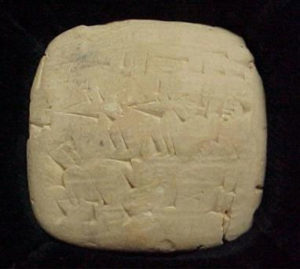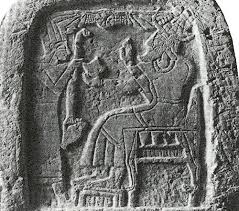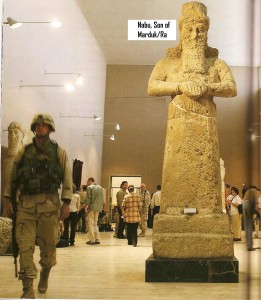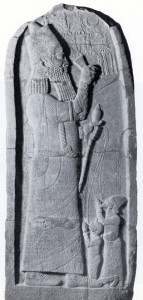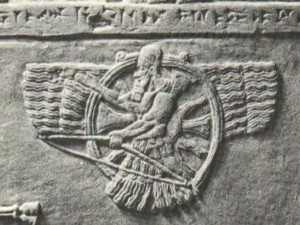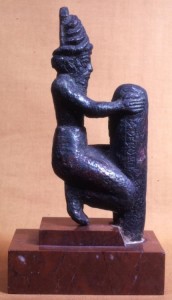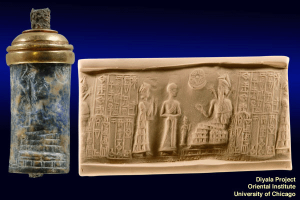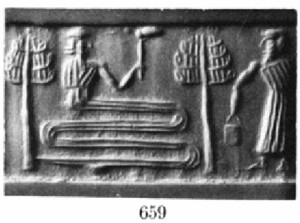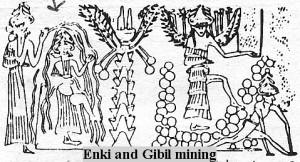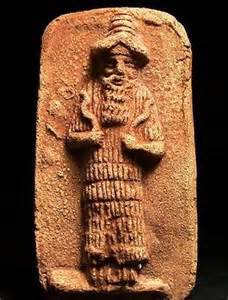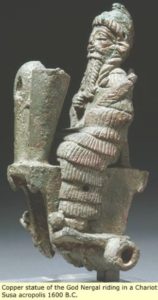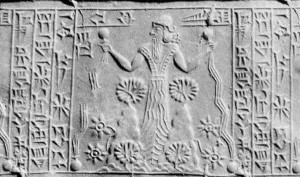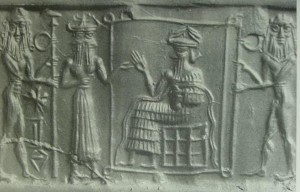(Daughter to Sargon The Great)
“Biography of Enheduanna, Priestess of Inanna”2285-2250 B.C.
by Roberta Binkley
[Copyright 1998 Roberta Binkley]
Enheduanna is at once a mystical and heroic figure, one whose image may be destined to take hold of the popular imagination in an era of emerging feminism and the reclaiming of ancient feminine images. She is the world’s oldest known author whose works were written in cuneiform approximately 4300 years ago. Two of her known works are hymns to the goddess Inanna, The Exaltation of Inanna and In-nin sa-gur-ra. A third identified work, The Temple Hymns, addresses the sacred temples and their occupants, the goddess or god to whom they were consecrated. In each of these works she steps forward to speak in the first person moving from the third.
Although Enheduanna lived 4300 hundred years ago (ca. 2285-2250 B.C.E.), her existence as a historical personage is well established. There is the disk that has been restored evacuated from Ur with her image, and written historical records indicate that she was the daughter of Sargon of Akkad, the first ruler to unite northern and southern Mesopotamia. Her mother was a Sumerian from southern Mesopotamia, perhaps a priestess. Sargon was also purported to be the son of a priestess.
In the photograph of the disk of Enheduanna, she stands second in a line of four figures, preceded by a nude male priest and followed by two male attendants. She wears a flounced dress and a rolled brimmed turban, the aga, which she refers to in The Exaltation of Inanna as ‘the true cap/the sign of (appropriate to) en-ship’ (l.107). She was the high (en)priestess of the moon god, Nanna.
On the back, in a column of eleven cases, an inscription identifies Enheduanna as the ‘wife (dam) of Nanna [the Sumerian moon god] and daughter of Sargon’ (192). Winters notes that the nude priest pouring the libation and Enheduanna share the center of the disk. If the restoration is accurate, according to Winters, ‘only Enheduanna’s head actually touches the upper margin of the frieze–the violation of isocephaly serving to emphasize her dominant position’ (192-3).
While the disk represents the four figures making a ritual offering to the moon god, it is interesting that among Enheduanna’s works so far found, her major work, the hymn The Exaltation of Inanna–translated in 1968 by Willo and J. J. A Van Dijk–addresses the goddess Inanna. Apparently her official title was en (high-priestess) to the god Nanna, yet her passionate affiliation appears to have been to the goddess Inanna. Of her five recovered works, two are long hymns to Inanna.
The combined roles of priestess and princess may have set a precedent in Sumerian history that followed for the next five centuries. Scholar William W. Hallo explains that she was a personality ‘who set standards in all three of her roles for many succeeding centuries…’ (1). The names of high priestesses appear in historical lists just as do the kings testifying to interesting political and cultural implications of power, at least of royal women. For the next 500 years between sovereigns, the priestesses provided continuity of government.
“Enheduanna: An Overview of Her Writings”
(gods in blue …mixed-breed demigods in teal…)
by Roberta Binkley
[Copyright 1998 Roberta Binkley]
The Exhaltation of Inanna
The Exhaltation of Inanna, translated from the cuneiform by Hallo and van Dijk in a 1968 text edition runs 153 lines. It is the most widely known of her works, perhaps because of the completeness of the translation. It is carefully set up in a format, echoing the cuneifom exemplars, of two column stanzas that can often be read down as well as across. The hymn begins with a 65-line exordium of epithets and description, all carefully selected to illustrate the characteristics of the goddess. These epithets “arranged in a conscious sequence — worthy of the wisdom of an Amos — in which the range of Inanna’s activities is brought ever closer to the (presumable) audience of the poem” (48). Enheduanna implies Inanna’s equality with An, the senior god of the Sumerian pantheon which Hallo suggests politically equates the Sargonic kings as adhering to Sumerian norms and beliefs in order to justify Akkad’s imperial rule over Sumer (7).
Next Enheduanna depicts Inanna as disciplining mankind as a goddess of battle. She thereby unites the warlike Akkadian Ishtar’s qualities to those of the gentler Sumerian goddess of love and fecundity. She likens Inanna to a great storm bird who swoops down on the lesser gods and sends them fluttering off like surprised bats. Then, in probably the most interesting part of the hymn, Enheduanna herself steps forward in the first person to recite her own past glories, establishing her credibility, and explaining her present plight. She has been banished as high priestess from the temple in the city of Ur and from Uruk and exiled to the steppe. She begs the moon god Nanna to intercede for her because the city of Uruk, under the ruler Lugalanne, has rebelled against Sargon. The rebel, Lugalanne, has even destroyed the temple Eanna, one of the greatest temples in the ancient world. Further, he has dared to equate himself as an equal to the new high priestess and–in the most ancient recorded instant of sexual harassment–made sexual advances to the high priestess, his sister-in-law.
In the swelling of the “Magnificat”–a liturgy (lines 122-35)–the long hymn reaches its title theme. Enheduanna recites the me’s, divine attributes, of and to Inanna, again exalting her to equal status with the supreme god of pantheon, An. The hymn moves on to the peroration, a passage “unique to Sumerian literature describing the process of poetic inspiration” (Hallo, Exaltation 62). The poetess characterizes her creative labors as giving birth, i.e. “conceiving the word.” Then in the next stanza (lines 143-50) Enheduanna reverts to the third person as the simultaneous exaltation of Inanna and the restoration of Enheduanna are proclaimed. The concluding three-line doxology conveys the sense of the goddess and her poetess emerging triumphant.
In The Exaltation of Inanna there is a strong authorial presence that may be unmatched in ancient literary creation until the time of Sappho. She is self-consciously present in the process of writing and in the poem. The double “I” of the creatrix, Enheduanna and Inanna, are always at the center. And the hymn becomes a rhetorical creation of passionate complexity, one of death and birth, destruction and creation . . . those things that occupy the deepest part of the psyche.
She speaks of both her own and also by extension of the creative process itself near the end of the hymn. Through Inanna, Enheduanna has received the inspiration for the poem.
- 136 One has heaped up the coals / prepared the lustration (in the censer),
- 137 The nuptial chamber awaits you / let your heart be appeased!
In the lines above she intimates that she prepared herself to receive poetic inspiration–madness as Plato would characterize it. But Plato’s characterization of madness implies the purposelessness of chaos, and Enheduanna’s creative process is a very purposeful receiving. She heaps the coals in the censer and prepares the lustration to receive her greater self, her transcendent self, the Goddess. Her creative process appears to be one of intimate interaction with the Goddess. For a time in the middle of the night, they become one and out of that union comes the song.
I read her as at once inspired by the Goddess–she receives creative in-spiriting–and at the same time a poetess whose work comes from her own unique being while in a state of passionate and consuming love for the Goddess.
- 139 That which I recited to you at (mid)night
- 140 May the singer repeat it at noon! to you
Enheduanna’s own physical self-image also appears to be one of beauty and strength. She speaks of her “mellifluous” mouth (25, line 71) and mourns when her “choicest features are turned to dust” (line 72). She does not doubt her place:
- 66 Verily I had entered my holy giparu at your behest
- 67 I, the high priestess, I, Enheduanna!
- 120 (Yet) I am the brilliant high priestess of Nanna
In this work, the persona of Enheduanna appears as both physical and transcendent. She is a professional, a high priestess who is not only a possessor of the privileges of the rank and office, but she carries the burdens, the responsibilities . . . and the grief of that sometimes terrible role.
- 105 Like a swallow he made me fly from the window, my life is consumed.
- 117 (But) my own sentence is not Concluded. / A hostile judgment appears before my eyes as my judgment.
- 82 Let me give free vent to my tears like sweet drink for the holy Inanna!
In her personal role and her role as priestess she has had to watch the destruction of people, temple and sacred rites:
- 85 (Lugalanne) has altered the lustrations of holy An and all his (other rites).
- 86 He has stripped An Of (his temple) Eanna.
- 87 He has not stood in awe of An-lugal
- 88 That sanctuary whose attractions are irresistible, whose beauty is endless,
- 89 That sanctuary he has verily brought to destruction.
She speaks of her awareness of her own humanity and her limitations.
- 84 I cannot appease Ashimbabbar (Nannar)
- 92 In the place of sustenance what am I, even I?
But, finally, in the end there is a transcendence–and perhaps apotheosis–of both her person and that of her goddess when she steps back and in the third person describes the sumptuous vestments of the goddess and her priestess, vestments symbolic of both their spiritual and physical beauty.
- 146 The day was favorable for her, she was clothed sumptuously / she was garbed in womanly beauty.
- 147 Like the light of the rising moon, / how she was sumptuously attired!
Then she recounts that:
150 The (heavenly) doorsill called “Hail!”
Mircea Eliade explains the symbolic importance of a threshold in what he calls palaeo-oriental cultures (Babylon, Egypt, Israel). Thresholds, the door-sill shows the solution of continuity in space immediately and concretely; hence their great religious importance, for they are symbols and at the same time vehicles of passage from the one space to the other” (25). Thus Inanna in the form of her representative, the high priestess Enheduanna, stands at the threshold of heaven and earth, communicating between the two. Finally Enheduanna alludes the poem in praise and exaltation of Inanna.
- 151 For that her (Enheduanna’s) speaking to the Hierodule (Inanna) was exalted.
- 152 Praise be (to) the devastatrix of the lands, endowed with me’s from An,
- 153 (To) my lady wrapped in beauty, (to) Inanna!
The Goddess and her poet have both prevailed. Once exiled, they have been restored to their rightful places and they are both wrapped in the beauty of transcendent feminine energy and power.
Enheduanna’s long-forgotten poem–only translated in 1968- also foreshadows her own history and the history of women in religion, literacy, and western civilization for the next 4800 years.
- 70 They approach the light of day, about me, / the light is obscured
- 71 The shadows approach the light of day, / it is covered with a (sand) storm.
In-nin sa-gur-ra
Assyriologists traditionally title works by their first line, hence the title In-nin sa-gur-ra. This work, translated by Ake Sjoberg, and using 29 texts and fragments, is published (1976) as “In-nin-sa-gur-ra: A Hymn to the Goddess Inanna by the en-Priestess Enheduanna.” Although at 274 lines, it is the longest work so far discovered by Enheduanna it is much less complete than the translation of The Exaltation of Inanna. In all 57 lines are missing at important points in the composition. The text breaks off entirely at the point that Enheduanna steps forward: “I am Enheduanna, the en-Priestess of Nanna,……, I am the … Of Nanna“ (199). The Sjoberg translation does not begin again until line 243 with Enheduanna still speaking in the first person. When the text resumes Enheduanna still speaks of her own experience of punishment. The translator speculates her punishment may have been sent by Inanna to discipline Enheduanna: “‘I have experienced your great punishment’… this statement clearly indicates that Enheduanna had offended the goddess who then had punished her” (163). In a footnote on the same page, he notes that another translation is possible. “‘My body has experienced your great punishment,'”…referring to a disease sent against the en-Priestess by Inanna” (163). In any case, her apparent recovery must have occurred because she ends the hymn praising Inanna “My Lady, I will proclaim your greatness in all lands and your glory!” (254).
The main theme of the hymn according to Sjoberg is “Inanna’s omnipresent and omnipotent role in human affairs” (163). He criticizes the hymn as containing unnecessary repetition:
- 49 she turns the midday light into darkness”
- 177b Turning darkness into light
Sjoberg also explains that “you alone are great” occurs in both line 182 and 218 and with a variation in line 96. Such a critique is difficult to sustain since as a hymn it would be sung and the echoing lines, it could be argued, might be important in their placement. Furthermore, since Sjoberg spends only a page and three-quarters discussing the literary structure, a discussion that primarily summarizes the form and contents of the hymn, to critique it on these grounds for one-fourth of the section given the fact that so many lines are missing seems to me to be somewhat hasty.
The structure of the hymn is similar to The Exaltation. In lines 1-90 Enheduanna praises Inanna’s power speaking in the third person, more as a distant observer of the goddess and her power, relating the deeds that show that power:
- 4 She is the August leader among the great gods, she makes the verdicts final.
- 10 Her radiance covers the great mountain, silences the road.
- 11 The gods of the land are panic stricken by her heavy roar.
- 14 Without Inanna the great An has not made a decision, Enlil has not determined the destiny. (179)
Then Enheduanna speaks of Inanna’s anger as it’s reflected by the people:
- 45 She washes their (?) weapons with blood and gore,….,
- 53 Her murderous battle no one can oppose–who rivals her?(183)
Beginning with line 91 she then speaks to Inanna in the second person addressing her as “you.” Again, she notes that Inanna rivals An and Enlil, “You sit on their seat” (187). Lines 115-172 repeat the refrain in every line “are yours, Inanna” explaining and enumerating Inanna’s attributes and her contributions to civilization.
- 116 To run, to escape, to quite and to pacify are yours, Inanna. (189)
- 124 Information, instruction, inspection, to took closely, to approve are yours, Inanna. (191)
Not until line 219 does Enheduanna step forward in the first person, “I am Enheduanna, the en-Priestess of Nanna” (199). Here the poem breaks off until line 243 where it begins:
- 243 Advice (…)
- 244 Grief, hardship…
- 245 My Lady,…mercy….compassion….
- 246 I am yours! It will always be so! May your heart cool off for me,
- 250 I have experienced your great punishment (199)
She concludes the hymn:
- 270 My Lady, Your greatness is manifest,
- 271 May your heart for my sake ‘return to its place’!
- 272 Your great deeds are unparalleled,
- 273 Your greatness is always praised,
- 274 Young woman, Inanna, your praise is sweet!
Although longer than The Exaltation, as I stated in the beginning, the rhetorical structure is similar. Both works open with an exordium of epithets and descriptions selected to illustrate the characteristics of the goddess. In the Exaltation the opening is 65 lines versus the In-nin sa-gur-ra opening of 90 lines. Both works move from an opening address of Inanna in third person to addressing her in second person. In both hymns there is a section exalting Inanna. In the Exaltation it occurs in lines 122-135 where each stanza ends with “be it known!” (31-32). In In-nin sa-gur-ra lines 115-172 end with “are yours, Inanna“ (189-197). Since almost the entire section of In-nin sa-gur-ra in which Enheduanna steps forward in first person are missing, 24 of the most important lines in the hymn, it cannot be compared to The Exaltation except to say that this section which is the most personal contains the reason that Enheduanna speaks to Inanna, why she writes the hymn. It is in this personal section, that Enheduanna seems to explain her motivation and her process. In The Exaltation, she adds her meta commentary that helps to illuminate the meaning of the hymn on a personal, psychological, and universal level. Finally, both works conclude with a doxology to the goddess, once more returning to the theme of exaltation.
The Temple Hymns
The Temple Hymns are very different in character from the two works just discussed. They were translated by Ake Sjoberg in collaboration with E. Bergmann, S.J. in 1969. They consist of 42 hymns of various lengths addressed to temples. Each hymn follows the same form. The hymn directly addresses the temple in second or third person describing it in epithetical statements. For example the first Temple Hymn opens:
- Eunir, which has grown high, (uniting) heaven and earth,
- Foundation of heaven and earth, ‘Holy of Holies’, Eridu, (17)
She concludes each hymn by identifying the temple, naming the city and the god or goddess to whom it is dedicated. The narrative moves from the outside to the inside. In each of the hymns Enheduanna speaks to the holy place describing its significant sacred structure, “you have grown high, binding heaven and earth, fixing the above and the below” (28). She then moves inside to describe the sacred activities “where pure food is eaten” and the holy objects contained within such as the drum or the ovens. (17)
At the conclusion of the hymns, Enheduanna steps forward:
- The compiler of the tablet (is) Enheduanna
- My Lord, that which has been created (here) no one has created (before) (49).
The Temple Hymns contain several added later by scribes, hymns to temples that did not exist at the time Enheduanna wrote. Thus, her original creation was one that scribes continued to amend in a posthumous collaboration with the author, one who may have become a deity in her own right.
Additional Works
There are two additional works translated by scholar Joan Goodnick Westenholz, one by Enheduanna that she apparently wrote on the assumption of the en-ship (office of high priestess) to the moon god Nanna. The second fragmentary work, dedicated to Enheduanna and apparently written by an anonymous scribe, indicates her apotheosis during or immediately after her death, according to Westenholz. (539)
She is shining The en-priestess chosen for the pure “divine offices,”
Enheduanna may the she bring you your prayer to the abzu.
The one who is worthy for Suen, my delight/pride… (555)
